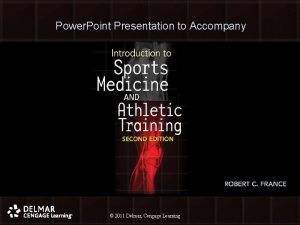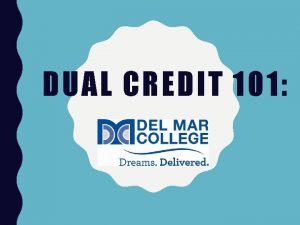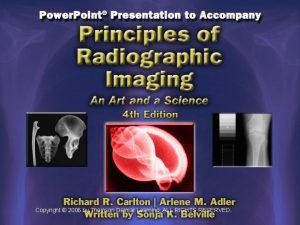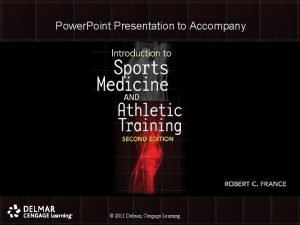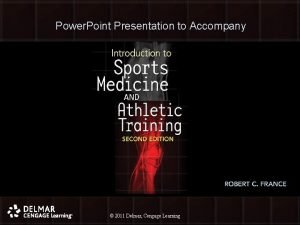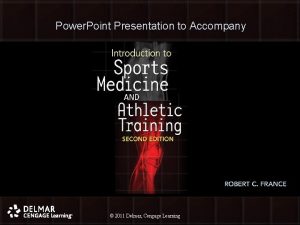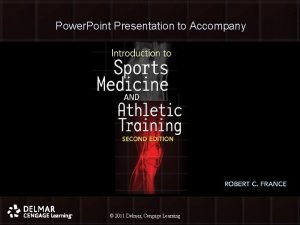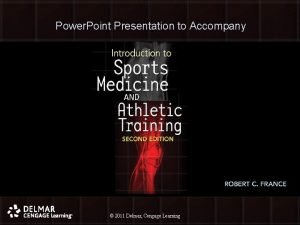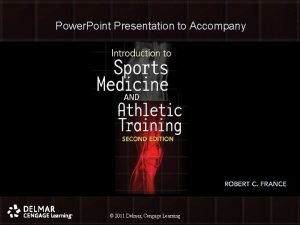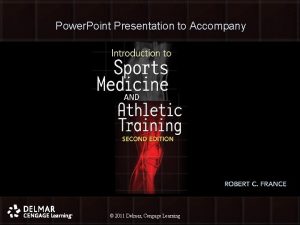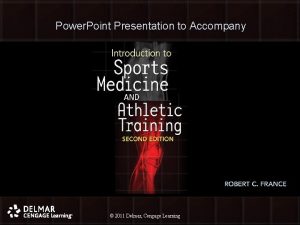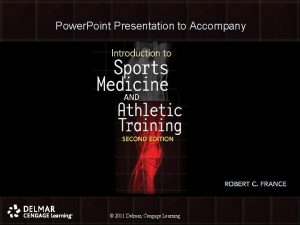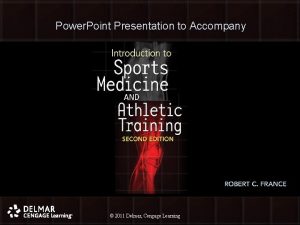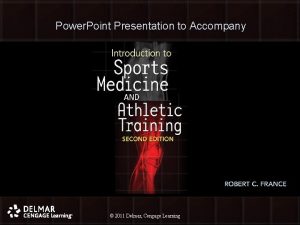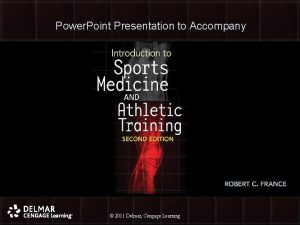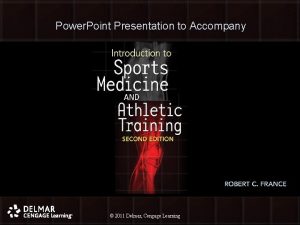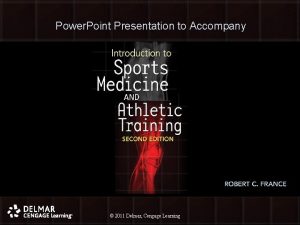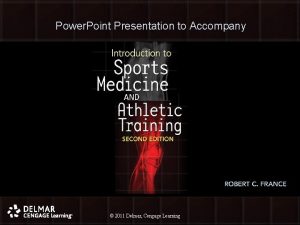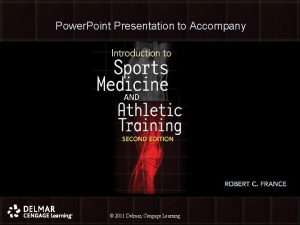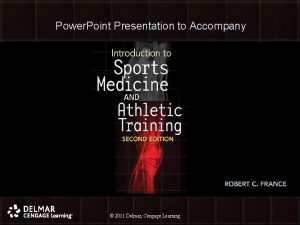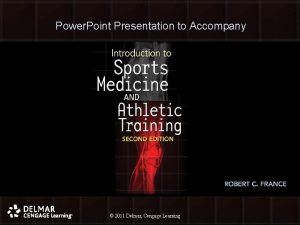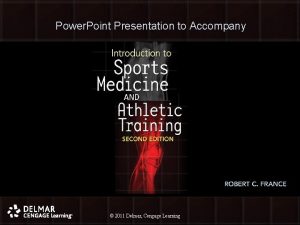Power Point Presentation to Accompany 2011 Delmar Cengage





















- Slides: 21

Power. Point Presentation to Accompany © 2011 Delmar, Cengage Learning © 2010 Delmar, Cengage Learning

Chapter 11 Assessment and Evaluation of Sport Injuries © 2011 Delmar, Cengage Learning © 2010 Delmar, Cengage Learning 2

Objectives • Upon completion of this chapter, you should be able to: – Explain the difference between assessment, evaluation, and diagnosis of an injury – Describe the various factors that influence the type and severity of athletic injuries – Evaluate an athletic injury using a systematic approach © 2011 Delmar, Cengage Learning © 2010 Delmar, Cengage Learning 33

Objectives (cont’d. ) • Upon completion of this chapter, you should be able to (cont’d. ): – Explain the different methods and reasons for documenting injuries © 2011 Delmar, Cengage Learning © 2010 Delmar, Cengage Learning 44

Assessment and Evaluation of Athletic Injuries • Orderly collection of objective and subjective data on health status – Based on professional knowledge and knowledge of events that occurred • Knowledge of ATC helps in getting proper aid to the athlete quickly – ATC can evaluate injury, but they cannot diagnose • Licensed health care providers diagnose © 2011 Delmar, Cengage Learning © 2010 Delmar, Cengage Learning 55

Assessment and Evaluation of Athletic Injuries (cont’d. ) • Diagnosis – What licensed provider states to be the problem, based on skills, expertise, and training • Physician uses all information obtained to arrive at a diagnosis • ATC uses information to set short- and long-term goals for recovery © 2011 Delmar, Cengage Learning © 2010 Delmar, Cengage Learning 66

Factors Influencing Athletic Injuries • Anthropomorphic data – Size, weight, structure, gender, strength, and maturity level • Mechanism of force – All forces involved at the time of an impact • Speed – Greater speed, greater injury chances © 2011 Delmar, Cengage Learning © 2010 Delmar, Cengage Learning 77

Factors Influencing Athletic Injuries (cont’d. ) • Protective equipment – Reduces risk of injury – Absorbs and distributes force • Skill level – Beginners are at greater risk © 2011 Delmar, Cengage Learning © 2010 Delmar, Cengage Learning 88

Recognition and Evaluation • Recognition of injuries – ATC determines probable cause and mechanism of injury • May be based on direct observation or second-hand accounts © 2011 Delmar, Cengage Learning © 2010 Delmar, Cengage Learning 99

Recognition and Evaluation (cont’d. ) • Primary injury survey – Determining if injury is serious or lifethreatening • ABCs: airway, breathing, and circulation • High-quality bystander cardiopulmonary resuscitation can double or triple survival rates from cardiac arrest © 2011 Delmar, Cengage Learning © 2010 Delmar, Cengage Learning 1010

Recognition and Evaluation (cont’d. ) • Secondary injury survey – Methodical evaluation of an athlete’s overall health – H. O. P. S. (history, evaluation, palpation, special tests) method • • Be thorough Gather a history Expose the injury Perform a physical evaluation © 2011 Delmar, Cengage Learning © 2010 Delmar, Cengage Learning 1111

Recognition and Evaluation (cont’d. ) • Observation – Compare the injured side to the uninjured • Palpation – Touching to determine the extent of the injury • Active motion – Athlete attempts to move body part through full range of motion © 2011 Delmar, Cengage Learning © 2010 Delmar, Cengage Learning 1212

Recognition and Evaluation (cont’d. ) • Passive motion – Movement through a range of motion performed by examiner while athlete relaxes muscles • Strength test – Begin isometrically without resistance, and then through the range of motion against resistance © 2011 Delmar, Cengage Learning © 2010 Delmar, Cengage Learning 1313

Recognition and Evaluation (cont’d. ) • Stability test – Investigates ligamentous laxity • Special examinations – Functional activity test • Determines level of activity athlete may resume – Specific sport activity test • Determines if it is safe to resume activities of a particular sport © 2011 Delmar, Cengage Learning © 2010 Delmar, Cengage Learning 1414

Return-to-Play Criteria • Full strength – Damage to surrounding soft tissue must be healed – Muscles supporting injury must be 100% preinjury strength • Free from pain – True pain is an indication of an unhealed injury – Mild soreness is okay © 2011 Delmar, Cengage Learning © 2010 Delmar, Cengage Learning 1515

Return-to-Play Criteria (cont’d. ) • Skill performance tests – Simulate skills required for the sport – Should begin at a low level of intensity and gradually increase © 2011 Delmar, Cengage Learning © 2010 Delmar, Cengage Learning 1616

Return-to-Play Criteria (cont’d. ) • Emotional readiness – Counseling will help the athlete work through any hesitation about returning to play – Athletes who do not perform at 100% will be prone to new injuries – Always ask the athlete if they are ready • An athlete who is hesitant or does not feel ready should not be allowed to return © 2011 Delmar, Cengage Learning © 2010 Delmar, Cengage Learning 1717

Documentation of Injuries • Important for many reasons – Most important is follow-up care – Helps keep the athlete from going without care needed – Database creation helps uncover trends • Allows coaching staff to target areas of concern – Beneficial in case of lawsuits © 2011 Delmar, Cengage Learning © 2010 Delmar, Cengage Learning 1818

Documentation of Injuries (cont’d. ) • Formats for reporting injuries: – SOAP notes – Daily sideline injury reports – Training-room treatment logs – Daily red-cross lists – Athlete medical referral forms © 2011 Delmar, Cengage Learning © 2010 Delmar, Cengage Learning 1919

Conclusion • Athletic injuries are inevitable • Care and treatment of injuries constitute an important aspect of a sports medicine program • Certified athletic trainers complete assessments and write referrals © 2011 Delmar, Cengage Learning © 2010 Delmar, Cengage Learning 2020

Conclusion (cont’d. ) • Physicians diagnose the injury and prescribe a treatment plan • Accurate record keeping is important © 2011 Delmar, Cengage Learning © 2010 Delmar, Cengage Learning 2121
 2009 delmar cengage learning
2009 delmar cengage learning 2009 delmar cengage learning
2009 delmar cengage learning Chapter 1 matching medical terminology
Chapter 1 matching medical terminology Graphing tpr
Graphing tpr 2009 delmar cengage learning
2009 delmar cengage learning Chapter 13 medical math assignment sheet cengage learning
Chapter 13 medical math assignment sheet cengage learning 2009 delmar cengage learning
2009 delmar cengage learning Delmar cengage learning instructor resources
Delmar cengage learning instructor resources Things that accompany salvation
Things that accompany salvation Accompany chapter 1
Accompany chapter 1 Apical group of axillary lymph nodes
Apical group of axillary lymph nodes Printers create objects such as prototypes and models.
Printers create objects such as prototypes and models. Ppt on hindi topics
Ppt on hindi topics Power point presentation design west vancouver
Power point presentation design west vancouver Delmar isotonic
Delmar isotonic Delmar tsi
Delmar tsi Delmar international (thailand) co. ltd
Delmar international (thailand) co. ltd Thomson delmar learning
Thomson delmar learning Borgify
Borgify Real power and reactive power
Real power and reactive power Powerbi in powerpoint
Powerbi in powerpoint Point point power
Point point power














